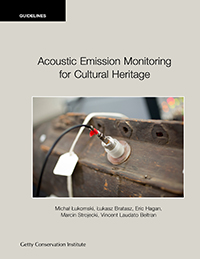Michał Łukomski, Łukasz Bratasz, Eric Hagan, Marcin Strojecki, Vincent Laudato Beltran, 2020 | ||||||
|
These technical guidelines are designed for conservation scientists and conservators actively seeking to deploy acoustic emission (AE) monitoring as a means of tracing physical change in cultural heritage objects. Aiming to provide comprehensive information about AE hardware and sensors, measurement protocols, and methods of data analysis, this publication also examines the advantages and limitations of the technique for detecting, recording, and interpreting damage. AE is a highly sensitive technique capable of monitoring the ongoing damage process in materials and objects and has considerable potential to support the assessment of existing climate control strategies and the development of alternative approaches. In November 2017, scientists and conservators experienced with AE convened at the Getty Conservation Institute to discuss the current state of the technique. During this meeting, the idea of creating technical guidelines on the applicability of AE in the cultural heritage field was born. Beginning with an introduction to the AE monitoring technique that highlights its nondestructive potential, the guidelines elaborate on the different types of systems and sensors, attenuation of AE signals, positioning and mounting of sensors, data analysis and interpretation, and how to link AE with damage. Also considered are more advanced strategies for noise reduction, AE source location, and frequency analysis. The conclusion then touches upon the use of AE as an early warning system, particularly when objects are subject to changing environmental conditions. How to Cite this WorkŁukomski, Michał, Łukasz Bratasz, Eric Hagan, Marcin Strojecki, and Vincent Laudato Beltran. 2020. Acoustic Emission Monitoring for Cultural Heritage. Los Angeles: Getty Conservation Institute. http://hdl.handle.net/10020/gci_pubs/acoustic_emission |
|
||||||||||||||
